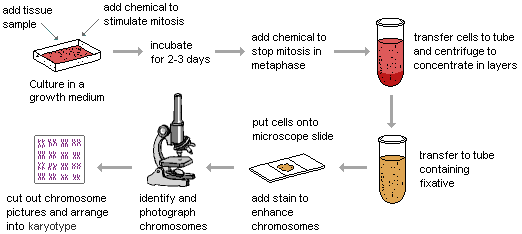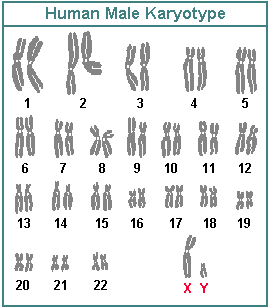Every human
pregnancy that goes to full term in North America and other
modern industrialized nations has a small risk (about 2-3%) of
serious birth defects. This is the case even when
the mother is young and healthy. However, some pregnancies are at a higher risk due
to a variety of factors. Fortunately, it is now possible to connect some of the inherited
genetic defects to specific chromosome irregularities. This can be done by examining small
tissue samples from adults, children,
or even unborn babies. The samples are
cultured to induce mitosis so that the chromosomes
become visible. In this state, the chromosomes can be photographed. The images
are then converted into a karyotype of the individual
from whom the sample was taken. This involves the precise measurements of chromatid length ratios and other morphological features
so that they can be placed into homologous
pairs.
 |
|
Cells cultured to produce a karyotype (Much of this process is now facilitated with computers.) |
 |
|
On comparison with a normal karyotype, major abnormalities can be discovered in a
suspect sample. Irregular numbers of chromosomes and missing or deformed
chromatids
are easily observed. Many types of gross chromosomal abnormalities have been
connected to specific medical syndromes
![]() , including mental retardation.
, including mental retardation.
By sampling embryonic
![]() or fetal
or fetal
![]() cells within the uterus
cells within the uterus
![]() of a mother, it is possible to determine
whether or not her child will be born with serious genetic problems. More than 80
common types of chromosomal abnormalities are now identifiable by this method. The
unborn child's gender can also be determined by noting whether its karyotype includes X and Y
sex chromosomes or only X's. Gender is important because of the higher probability of
males expressing X-linked traits in their phenotypes.
of a mother, it is possible to determine
whether or not her child will be born with serious genetic problems. More than 80
common types of chromosomal abnormalities are now identifiable by this method. The
unborn child's gender can also be determined by noting whether its karyotype includes X and Y
sex chromosomes or only X's. Gender is important because of the higher probability of
males expressing X-linked traits in their phenotypes.
By this simple examination of karyotypes, it is not possible to discover mutations that occur at the gene level. That is to say, mutations in the DNA molecules that make up chromosomes are not usually detected by this process. Since it is likely that most of the more than 5,000 known genetic disorders are at this lower level, karyotype analysis is limited. However, those disorders that are due to gross chromosomal irregularities are comparatively common and often serious. As a result, karyotype analysis and other associated tests have become important medical tools.